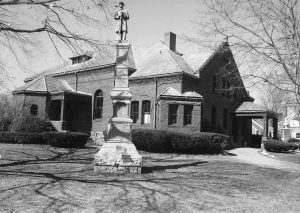In 1998, the Sippican Historical Society commissioned an architectural survey of Marion’s historic homes and buildings. The survey was funded one-half by the Sippican Historical Society and one-half by the Massachusetts Historical Commission. Because of the limits of funding, not all of the historic buildings were surveyed, but over 100 were catalogued and photographed. The results of the survey are in digital form on the Massachusetts Historical Commission’s website and in four binders in the Sippican Historical Society’s office (and at the Marion Town Clerk’s office). Marion (Old Rochester) is one of the oldest towns in the United States, and the Sippican Historical Society maintains an extensive collection of documentation on its historic buildings. The Sippican Historical Society will preview one building a week so that the residents of Marion can understand more about its unique historical architecture. This installment features 164 Front Street.
Constructed of red brick with terra cotta and rock-faced brownstone trim, the Queen Anne-style Music Hall at 164 Front Street was designed by Boston architect William Gibbons Preston in 1891 and paid for by Elizabeth Pitcher Taber, who gave the building to the Town of Marion. A Soldier’s Monument made of cast iron is situated in front of the Music Hall. It was dedicated in 1894 as a tribute to local citizens who lost their lives in the American Revolution, the War of 1812, and the Civil War. The monument lists the battles in which Marion soldiers bravely served: Fort Fisher, Gettysburg, Cedar Creek and Lexington. An inscription reads: “Marion erects this monument to the Brave Defenders of the Union in Grateful Remembrance of their Valor and Devotion.”
